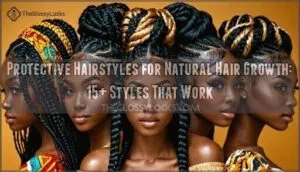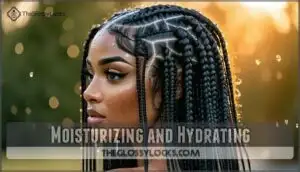This site is supported by our readers. We may earn a commission, at no cost to you, if you purchase through links.
 You’re on the right track when you choose protective hairstyles for natural hair growth that keep your ends tucked away and reduce daily manipulation.
You’re on the right track when you choose protective hairstyles for natural hair growth that keep your ends tucked away and reduce daily manipulation.
Box braids, twists, and low buns work like a security blanket for your strands, preventing breakage while locking in moisture.
These styles give your hair a break from heat, brushing, and environmental damage that can slow growth.
Think of them as putting your hair in "maintenance mode" where it can focus energy on growing instead of repairing damage.
The secret isn’t just picking any protective style, though—it’s about finding the perfect balance between protection and proper care techniques.
Table Of Contents
- Key Takeaways
- Benefits of Protective Hairstyles
- Popular Protective Hairstyles
- Preparing Hair for Styles
- Maintaining Protective Styles
- Choosing Right Protective Style
- Frequently Asked Questions (FAQs)
- What protective hairstyle makes hair grow faster?
- Which hairstyle is best for natural hair growth?
- What is the most protective hairstyle for natural hair?
- Which hairstyle helps hair growth?
- How often should protective styles be changed?
- Can protective styles cause hair thinning?
- Whats the best age to start protective styling?
- Do protective styles work on chemically treated hair?
- How much does professional protective styling cost?
- Conclusion
Key Takeaways
- You’ll retain more length by choosing protective styles like box braids, twists, and cornrows – these keep your ends tucked away from daily manipulation and environmental damage that causes breakage and prevents you from seeing your true growth potential.
- You must maintain proper moisture levels while wearing protective styles – apply leave-in conditioner weekly, use lightweight oils for sealing, and sleep with satin bonnets or pillowcases to prevent your hair from drying out underneath the protective style.
- You can’t keep protective styles in too long without consequences – change them every 6-8 weeks maximum to prevent product buildup, scalp irritation, and potential damage from styles that become too tight as your hair grows.
- You need to avoid excessive tension when installing protective styles – tight braids and heavy styles can cause traction alopecia and edge damage, so choose styles that feel comfortable and don’t create headaches or tender spots on your scalp.
Benefits of Protective Hairstyles
Protective hairstyles shield your natural hair from daily damage by keeping your ends tucked away and reducing the need for constant styling.
Shield your strands from daily damage while looking effortlessly chic – that’s the magic of protective styling.
These styles help you retain length, maintain moisture, and give your hair a break from heat and manipulation while still looking great, which is a key benefit of using protective hairstyles.
Reducing Hair Breakage
When you’re constantly styling and manipulating your hair, you’re basically asking for trouble.
Protective hairstyles shield your strands from daily wear and tear that causes breakage.
By tucking hair ends away and reducing friction, these styles prevent split ends and snapping.
You’ll notice less hair in your brush when you embrace gentle detangling and avoid over-styling with heat tools.
Promoting Hair Growth
Protective hairstyles create the perfect environment for natural hair growth by reducing stress on your strands.
When you’re not constantly styling, your hair can focus on getting longer. These styles keep your ends tucked away, preventing split ends that travel up the shaft.
You’ll notice improved length retention as your hair grows stronger and healthier underneath protective styling.
Minimizing Hair Manipulation
Every touch, brush, and style session puts stress on your strands.
Low manipulation styles give your hair the break it deserves from daily handling. These protective hairstyles create a "hands-off" approach that prevents unnecessary breakage.
Here’s how minimizing manipulation helps:
- Gentle Detangling reduces pulling and snapping of fragile strands
- Low-Tension Styles prevent stress at the root and along the hair shaft
- Minimal Styling eliminates daily combing that causes cumulative damage
Retaining Moisture and Hydration
Natural hair thrives when you lock in moisture through protective hairstyles. These styles create a barrier against environmental factors that steal hydration. Your hair stays softer longer when ends remain tucked away from daily friction.
| Moisture Method | Application | Benefits |
|---|---|---|
| Water-based Sprays | Daily light misting | Prevents dryness, refreshes style |
| Oil Scalp Massages | Weekly with lightweight oils | Stimulates circulation, adds shine |
| Satin Protection | Nightly bonnets/pillowcases | Reduces friction, maintains hydration |
Deep conditioning treatments with humectant ingredients support moisture retention while preventing hair breakage prevention in your natural hair care routine, which is essential for moisture retention and overall hair health, including the use of satin protection and oil scalp massages to keep your hair healthy and strong with daily light misting.
Popular Protective Hairstyles
You’ll find dozens of protective styles that work for every hair type, length, and lifestyle preference.
From classic box braids and cornrows to elegant updos and twisted crowns, these popular options protect your hair while keeping you looking stylish.
Box Braids and Variations
Box braids offer incredible versatility for your natural hair care routine.
These protective hairstyles shield your strands while promoting healthy hair growth tips.
You can customize them to match your lifestyle and personal style preferences.
Protective styles minimize hair damage by reducing sun exposure.
Here are four popular box braid variations to explore:
- Jumbo Braids – Quick installation in four hours or less
- Mermaid Braids – Colorful extensions for eye-catching looks
- Wavy Braids – Curled ends create romantic, flowing styles
- Braided Ponytails – Sleek updos that minimize heat damage
Cornrows and Twists
Moving beyond box braids opens doors to equally stunning options.
Cornrows and twists offer gentler alternatives that still deliver powerful protection for your hair growth journey.
These classic protective hairstyles create structured patterns while keeping tension minimal.
Cornrows distribute weight evenly across your scalp, while twists provide softer styling with easier maintenance access.
They primarily aim to protect hair ends from damage.
| Style Type | Wear Duration | Maintenance Level |
|---|---|---|
| Classic Cornrows | 2-4 weeks | Low |
| Flat Twists | 1-3 weeks | Medium |
| Two-Strand Twists | 1-2 weeks | Low |
| Cornrow Variations | 3-4 weeks | Low-Medium |
Both styles excel at edge protection and scalp health maintenance.
Twist styling allows more flexibility for daily adjustments, while cornrow variations offer extended style longevity.
Choose based on your hair’s current condition and desired maintenance routine to ensure the best results for your hair growth.
Updos and Bun Styles
Three simple bun variations can transform your protective hairstyles game.
You’ll love twisted chignons for updo occasions, while sock buns distribute weight evenly across your scalp.
DIY updos require minimal styling products – just leave-in conditioner and edge control for sleek edges.
These natural hair styles reduce manipulation by 50%, tucking ends safely away to promote hair growth through gentle protection.
Braided Crowns and Headwraps
Beyond simple buns, braided crowns and headwraps offer regal protection for your natural hair.
These protective hairstyles combine cultural significance with hair growth promotion, creating stunning looks that shield your strands.
Crown variations and headwrap fabrics provide endless styling techniques:
- Wrap single braids around your head like a halo
- Layer multiple thin braid styles for texture
- Use silk or satin headwrap fabrics to reduce friction
- Try asymmetrical braided crown patterns for modern flair
- Follow DIY tutorials for step-by-step guidance
Preparing Hair for Styles
Before you install any protective style, you’ll need to properly prepare your hair to guarantee the best results and prevent damage.
Clean, moisturized hair creates a strong foundation that helps your protective style last longer and keeps your natural hair healthy underneath.
Cleansing and Conditioning
Before diving into protective styling, proper cleansing and conditioning sets the foundation for healthy hair growth promotion. Your hair care routine should include gentle shampoo frequency of once weekly to avoid stripping natural oils.
Deep conditioning treatments restore moisture while removing product buildup that clogs follicles and hinders scalp health. Many people now seek gentler cleansing options for their hair.
| Hair Care Step | Benefits for Growth |
|---|---|
| Weekly shampooing | Removes buildup, maintains scalp health |
| Deep conditioning | Strengthens strands, prevents breakage |
| Scalp massage | Boosts circulation, stimulates follicles |
Choose sulfate-free hair care products and protein-rich conditioner types. Clean hair accepts protective styles better and promotes longer-lasting results for your hair care tips success.
Moisturizing and Hydrating
Proper moisture retention forms the foundation of successful protective hairstyles for natural hair growth. Your hair needs deep hydration before styling to prevent breakage and maintain scalp health throughout the protective period.
Essential hydration methods include:
- Apply leave-in conditioner from mid-shaft to ends
- Use water-based moisturizers for daily hydration
- Seal moisture with lightweight oils like jojoba
- Focus product selection on sulfate-free formulas
- Perform deep conditioning treatments weekly
Consider using quality hair products for best results, ensuring successful protective hairstyles and promoting natural hair growth with deep hydration.
Protecting Hair at Night
Your hair deserves royal treatment while you sleep. Nighttime protection prevents breakage and keeps protective hairstyles looking fresh.
Use satin bonnets or silk scarves for smooth coverage. Try the pineapple method for curls—gather hair loosely at your crown.
Apply lightweight nighttime oils for deep nourishment. Proper hair sleep routines maintain braid maintenance and extend style longevity.
Many find that using silk pillowcases reduces friction for a better sleep experience.
| Protection Method | Benefits | Best For |
|---|---|---|
| Satin Bonnets | Reduces friction, prevents tangles | All hair types, curly textures |
| Silk Scarves | Maintains moisture, gentle coverage | Braids, twists, natural styles |
| Pineapple Method | Preserves curl pattern, minimizes flattening | Curly hair, twist-outs |
| Hair Tie Down | Secures edges, maintains sleek styles | Straight styles, laid edges |
Avoiding Damage and Breakage
Like a delicate flower, your natural hair needs gentle handling to thrive.
Avoid tight styles that create excessive tension control around your edges. Heavy product buildup can weigh down strands and cause breakage.
Choose protective hairstyles that maintain moisture balance without pulling. Your hair care routine should prioritize edge protection and style longevity while promoting healthy hair growth through mindful manipulation.
Maintaining Protective Styles
You can’t just install a protective style and forget about it if you want healthy hair growth.
Proper maintenance keeps your style looking fresh while protecting your natural hair from damage and breakage.
Regular Cleaning and Maintenance
Your protective style needs regular attention to stay fresh and healthy.
Scalp cleansing every 2-3 weeks prevents product buildup that can clog follicles. Use diluted shampoo directly on your scalp, then follow with gentle oil massages to stimulate circulation.
Keep your hair care routine simple but consistent:
- Wash every 2-3 weeks to maintain scalp health without disrupting your style
- Apply lightweight oils weekly to keep your scalp nourished and happy
- Use night protection like satin bonnets to preserve style longevity
- Choose sulfate-free products to avoid stripping natural moisture from your hair
This routine guarantees your protective style stays comfortable while supporting healthy hair growth underneath.
Minimizing Tension and Friction
Too-tight braids spell trouble for your scalp health and edge protection.
You’ll want to avoid hair tension that leads to tension alopecia by choosing styles that don’t pull. Gentle removal prevents unnecessary hair manipulation when switching protective hairstyles.
Watch for signs like headaches or tender spots – these red flags mean your hair protection isn’t working and style longevity suffers.
To promote hair growth, consider incorporating weekly hair care routines, which can help with protective hairstyles and overall edge protection.
Using Gentle Hair Products
Gentleness becomes your hair’s best friend when selecting products for protective styles. Choose sulfate-free shampoos that won’t strip natural oils from your scalp.
Apply leave-in conditioners weekly to maintain moisture levels. Use lightweight natural oils like jojoba or argan for shine.
Incorporate protein treatments monthly to strengthen strands. Many brands offer diverse product options for different hair types.
Select scalp serums that promote healthy hair growth without buildup.
Scheduling Regular Touch-ups
Regular touch-ups keep your protective hairstyles looking fresh and your scalp healthy.
Schedule maintenance every 2-3 weeks to address edge maintenance and prevent product buildup.
This touch-up frequency guarantees style longevity while promoting natural hair growth.
Don’t wait until your style looks messy—consistent hair maintenance prevents tension and keeps your hair care routine on track for superior results.
Choosing Right Protective Style
You’ll need to match your protective style to your hair’s unique needs, considering your texture, length, and daily routine.
The right choice depends on how much time you can spend on maintenance, your hair goals, and which styles work best with your natural hair pattern.
Considering Hair Texture and Length
Your hair’s unique fingerprint determines which protective hairstyles will work best for you.
Hair density affects how much tension styles can handle, while texture matching guarantees your chosen style complements your natural curl pattern.
Length suitability matters – shorter hair needs mini twists, longer hair can handle box braids. Consider your growth stage and desired style longevity when selecting protective hairstyles for maximum hair growth results.
Personal Style and Preferences
Your personal style shapes which protective hairstyles feel authentically you.
Consider these factors when selecting your next look:
- Style Versatility – Choose styles that match your aesthetic, from sleek professional looks to bohemian twists
- Color Choices – Experiment with highlights, ombre effects, or bold hues in braids and extensions
- Accessorizing Styles – Add headbands, scarves, or jewelry to personalize your protective hairstyles
- Cultural Significance – Honor traditional braiding patterns that connect you to your heritage
- Confidence Boost – Select hair styling options that make you feel powerful and beautiful
Natural hair styling should reflect your personality while protecting your strands.
Lifestyle and Maintenance Needs
Your busy schedule shapes which protective hairstyles work best for you.
If you’re constantly on the go, choose low-maintenance styles like box braids or twists that require minimal daily styling.
Consider your activity level – gym enthusiasts need styles that handle sweat and frequent washing.
Factor in your scalp health needs and how often you can commit to retightening schedules for ideal hair care.
These styles are great for retaining hair moisture and reducing dryness.
Hair Growth and Protection Goals
Define your specific hair growth and protection goals before selecting a style.
If you’re focusing on length retention, choose low-manipulation options like box braids or twists that support your growth cycle.
For damage prevention and scalp health, prioritize styles that maintain hydration balance without excessive tension.
Your protective hairstyles should align with your natural hair care objectives and timeline.
Frequently Asked Questions (FAQs)
What protective hairstyle makes hair grow faster?
Like seeds sleeping under winter’s blanket, your hair needs protection to flourish.
Box braids, cornrows, and twists don’t actually speed growth—they preserve length by preventing breakage, letting you keep what you’ve grown, which is crucial for flourish.
Which hairstyle is best for natural hair growth?
You’ll see the best growth results with low-manipulation protective styles like box braids, cornrows, or twists.
These keep your ends tucked away, reduce breakage, and let your hair thrive while you focus on consistent moisturizing and gentle care.
What is the most protective hairstyle for natural hair?
Box braids offer the strongest protection for your natural hair.
They minimize manipulation, tuck away fragile ends, and can last six to eight weeks.
You’ll reduce breakage while promoting healthy growth with proper maintenance.
Which hairstyle helps hair growth?
Want hair that grows while you sleep?
You’ll find that box braids, cornrows, and twists create the perfect environment for growth by protecting your ends, retaining moisture, and minimizing daily manipulation that causes breakage.
This environment is crucial for growth by protecting your ends, which is essential for hair health.
How often should protective styles be changed?
You should change protective styles every 6-8 weeks maximum.
Don’t keep them longer than 8 weeks to prevent buildup, scalp irritation, and potential damage.
Your hair needs breaks between installations for proper cleansing and moisturizing.
Can protective styles cause hair thinning?
Yes, protective styles can cause hair thinning if they’re too tight, worn too long, or installed improperly.
You’ll notice thinning edges and breakage when there’s excessive tension on your scalp and hairline.
Whats the best age to start protective styling?
Coincidentally, many parents wonder about timing, but you can start protective styling as early as toddlerhood when your child’s hair grows longer.
There’s no specific age requirement—it’s about hair length and texture needs.
Do protective styles work on chemically treated hair?
Protective styles absolutely work on chemically treated hair.
You’ll find they’re actually gentler on relaxed or colored strands, reducing breakage while your hair recovers.
Just make certain you’re not pulling too tight on already-compromised hair, as protective styles are meant to be gentler.
How much does professional protective styling cost?
Professional protective styling costs vary widely depending on your location and chosen style.
You’ll typically pay $50-150 for basic braids, $100-300 for intricate styles like box braids, and $200-500 for premium techniques requiring extensive time.
Conclusion
Studies show that hair grows about six inches per year when properly protected from damage.
Protective hairstyles for natural hair growth aren’t just trendy—they’re your hair’s best defense against breakage and environmental stress.
You’ve learned the techniques, discovered the styles, and understand the maintenance routines.
Now it’s time to choose the right protective style that fits your lifestyle and hair goals.
Remember, consistency matters more than perfection when you’re growing healthy, strong natural hair.
- https://whizlaboratories.com/protective-haircare-tips/?srsltid=AfmBOoplXO1YsPi17SsbKGifqqQMacGf6P5kSEhIwXbAH43bpjWDp_-8
- https://www.lorealparisusa.com/beauty-magazine/hair-style/updo-and-bun-hairstyles/natural-hair-protective-hairstyles
- https://cecred.com/blogs/cecred-space/myth-busters-are-protective-styles-good-for-your-hair-health?srsltid=AfmBOorxVStFXJMjjj2MyleGjCa2e3qA_kuIzGPldg7Hq67wANAhlRWJ
- https://hairfreehairgrow.com/blog/protective-hairstyles/
- https://www.mdpi.com/2079-9284/9/1/17













